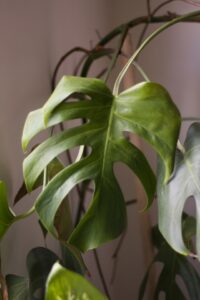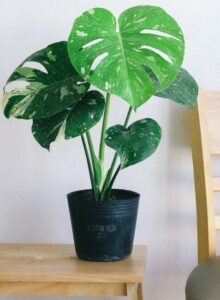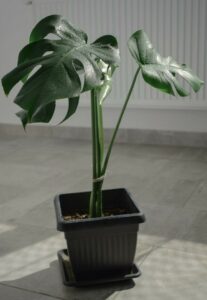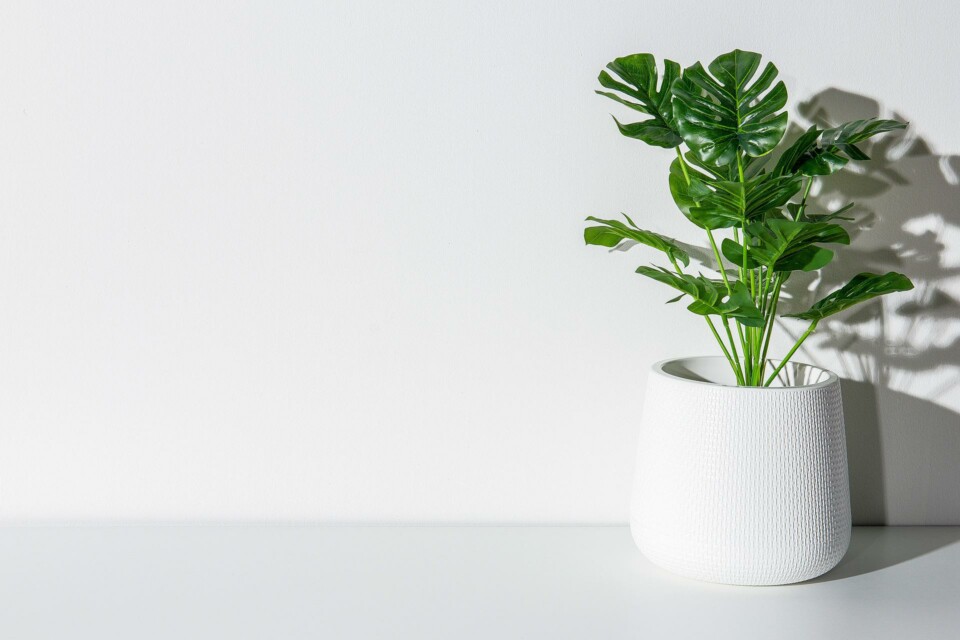Some links in the post are affiliate links and I get a commission from purchases made through some links found in the post.
In the right growing conditions, the monstera can be several feet tall. So, where you place your monstera matters a lot. First, it influences just how well your monstera can spread.
Monsteras often develop broad spreads, and if you leave them in constricted spots, you will limit how much they can grow.
Thus, a cramped corner in the office is not the best location. Secondly, the site where you locate the plant influences how much light it gets. It also plays a part in the humidity and temperature your monstera enjoy.
And this will ultimately affect how healthy it is and how much it grows. As such, you must weigh many factors before making what I can only refer to as one of the most crucial decisions when growing a monstera.
Ideas of a place in your house to keep your monstera are kitchens, bathrooms, dining areas, porches, and living areas.
To keep them healthy and happy you need to make sure you place your monstera where it can get adequate light, temperature and humidity, as well as you need to provide it with the correct watering and nutrition.
This guide takes you through the placement concerns and the best rooms to house your monstera. Let’s go:
Where To Place Your Monstera
Your monstera relies on photosynthesis to make food, giving it the energy to grow taller and healthier. And to make this food, it depends on light, water, and key nutrients.
The latter requirements do not matter much when placing a monstera indoors. After all, you oversee watering it and can change its potting mix as needed.
However, light is essential as it affects how well the monstera uses the water and nutrients at its disposal. Besides light, you must also consider the temperature and humidity of the room, as shown below:
Why Does Light Matter?
 Monsteras are native to Central American rainforests, where they grow among other species, receiving dappled light.
Monsteras are native to Central American rainforests, where they grow among other species, receiving dappled light.
This light, also known as filtered light, is bright and indirect, i.e., does not feature direct sun rays. Sometimes, the monstera comes into contact with the sun, but this does not last long.
Light has photons that impart energy to plants to trigger photosynthesis. And in the case of the monstera, this bright and indirect light is enough to do this.
Ideally, the plant should get at least 6 hours of such light. That stimulates energy production, which sustains plant processes and enables the plant to take up the water and nutrients in the soil.
You must consider light in two ways.
Too Much Light
When a monstera gets too much light exposure:
1) The plant’s leaves suffer damage: Too much sunlight can destroy the leaves. And when this happens, the plant loses part of its food-making capabilities.
To make matters worse, it uses the energy it has to heal the damaged leaves, which takes away from its ability to grow longer and broader. Unfortunately, you cannot reverse the damage and must prune these leaves to make way for new ones.
2) The plant’s transpiration and evaporation rates exceed its water absorption, and the plant ends up drooping. A drooping plant has less surface area exposed to the sun, affecting its food production.
You may also find that the soil feels dry to the touch because the plant has taken up more water to keep up with the water loss.
Such a plant will appear droopy and may even have browning edges on the sides of its leaves.
Too Little Light Exposure
Too much light stresses the plant, and you should avoid placing the plant near a spot that gets direct sun.
But what happens when you veer towards the other lighting extreme? When a plant has low light exposure, the results are not pleasant. Your monstera:
1) May show leggy growth
When a plant has reduced energy, it uses what it has to grow longer to reach more light and make more food. The monstera is not any different.
It is a climbing vine adapted to growing in the wild under the canopies. Using its aerial roots, it clings to other species and uses its upper leaves to support the food production for the entire plant.
But indoors, without a moss pole, this is not possible. So, the plant elongates its stem at a faster-than-usual rate, developing a weak and long stem with long internodal distances.
Such a plant is neither aesthetically pleasant nor strong enough to support the weight of the monstera.
2) May start developing small leaves
Monsteras have beautiful fenestrations that are part of their allure. When the plant does not have access to adequate light, it cannot produce the broad leaves characteristic of monsteras.
Instead, it uses what it has to develop small leaves with minor splits. And that also hurts its appearance.
3) May be at risk of overwatering
While you might think that soil loses water due to heat, much of the water supports the monstera’s activities.
The plant has turgor pressure that relies on continuous water absorption, evaporation, and transpiration.
Of course, when a plant is not getting enough light, some of these activities suffer, and the plant reduces its water uptake. And that leaves its roots sitting in water for extended periods, drowning them and damaging them.
Such a plant will show signs of yellowing and drooping. And if you do not step in fast enough, it could suffer root rot which is quite deadly.
- May have poor or no growth
What happens if a plant cannot produce enough energy to sustain its growth? It either grows with the little it has or stops growing at all. Unless the monstera is dormant, halted or no growth should not be present.
- May not fenestrate
When a monstera is mature and still has not shown signs of splitting, lighting is usually the issue.
The fenestrations are an adaptation to living in the wild, where the leaves split to allow light and water to get to the lower sections of the vines.
Of course, indoors, this adaptation mainly serves an aesthetic role. But it is still important to allow light to reach the lower sections of the plant. When the plant does not get enough light to create its food, it will not fenestrate.
The monstera may also show weak growth.
How To Avoid Lighting Extremes

Most people focus on lighting when choosing a spot for their plants. And as you have seen, it plays such a crucial role that ignoring it would only hurt your plant. So, how can you find the perfect spot for your monstera?
- Place the monstera near or against an east-facing window
The monstera does not like full sun but can withstand a few hours of the morning sun. If you notice that the plant is showing signs of too much sun exposure, you can move it away from the window such that none of the sun’s rays hit it.
- Locate the plant near (not against) a south-facing window if you live in the northern hemisphere
This spot receives a lot of bright and indirect light and will be ideal for your monstera. The vice versa also holds, i.e., locating the plant to the north if you live in the southern hemisphere.
- Avoid the west-facing windows in the home
These receive a lot of bright and direct afternoon sun whose rays can damage the monstera. Since sun damage to the leaves is irreversible, this is not a chance you should take.
- Use a moss pole to replicate the monstera’s growth in the wild
Having support for the plant allows it to spread its leaves and thus expose a bigger surface area, increasing the photosynthesis rate.
Moss poles work best as they have similar textures to the moss on tree barks. And this helps their aerial roots cling to the poles, which also has a striking aesthetic effect.
Ensure you leave the plant in a spot where it can get at least six hours of light daily. If this is impossible, consider getting artificial light with red and blue wavelengths.
It will similarly affect the plant’s photosynthesis and allow it to grow as you wish. LEDs are the best options for this as they are highly energy-efficient, cost-effective, and emit low light.
You can also use other lights, ensuring you observe at least 10 inches between the tips of the plants and the lights. You can adjust the position accordingly if you notice signs of limited or extreme light exposure.
What Temperature Does the Monstera Need?
The monstera, accustomed to growing in tropical regions, is picky about where it grows. Ideally, it should be grown in USDA zones 10 to 12, where the temperatures are pretty on the higher side.
Also, it prefers to be within the 65 to 75 degrees Fahrenheit range. The plant can tolerate temperatures up to 85 degrees Fahrenheit, but when you cross that threshold, issues arise, including:
- The rate of evaporation and transpiration may be too much for the plant to bear. As such, its leaves may start drooping due to heat stress as it cannot replace the lost water on time.
- The leaves may suffer damage because they have lost their protective barrier. If this continues for long, the leaves can start crisping and browning as they fall off the plant.
- The soil may dry out faster than it should, leaving the roots with no water to take up from the medium, dehydrating the plant.
These cases point to heat stress that can hamper the plant’s growth. But what happens when you go under the 65-degree-range?
Generally, monsteras go into dormancy when the temperatures drop. So, you will notice that the plant is either growing slowly or has stopped growing.
If this happens in seasons other than winter, you must raise the temperature; otherwise, the slow growth may result in leggy growth. But if it’s a consequence of seasonal changes, you can allow the plant to remain dormant.
Where can you place the monstera to avoid these changes?
- Ensure the plant is in a room where the temperatures do not fall below 65 degrees or exceed 85 degrees. That should be the case in most rooms in the house, even during the winter. But to be sure, you can always use a thermometer to gauge the current range.
- Keep the monstera away from heating vents as this would only dry out the plant and the soil. Instead, you should leave it at a neutral location, several feet away from the vents. And ensure that the warm currents do not face the direction of the plant.
- Leave the monstera in spots away from the windows and doors in the winter. The cold drafts may be below 60 degrees and could freeze the plant. If you know you will be using a particular door or window, do not locate your plant near it because this constant exposure could stress it.
- Please do not place the monstera near cooling vents: While it might seem like a good idea to leave it near a cooling unit, the continuous flow of cold air could hurt it.
Remember to water your monstera at least once a week to help it keep up with the increasing temperatures.
Check the state of the soil each time before watering it, and only proceed when the top two inches of the soil feel dry. Also, cut back on watering during the winter because the monstera will be dormant and will not need as much water.
Does Humidity Matter?

When monsteras are in low humidity, their transpiration and evaporation rates exceed their water absorption rates. As such, the leaves end up dry and crispy, hurting their growth.
Tropical plants thrive when they have water – around them and in their soil. A monstera requires regular watering, but where you place them will not affect this need much because you control how much water they get.
So, we scratch that and move to the water around them, i.e., humidity. Humidity is a measure of the level of water vapor in the air.
Luckily, you rarely see this because when the humidity levels drop in the winter, so do the temperatures, and the plants thus go dormant. But if you live in a region with low humidity, you might encounter this issue.
Moderate humidity is okay for monsteras as it somehow balances their water uptake and loss and keeps that turgor pressure going. But high humidity?
That’s the best kind of humidity as it engulfs the plant, much like in the rainforest, slowing the evaporation and transpiration rates such that the plant gets to soak in enough water.
And that’s when the plant starts showing signs of thriving.
How Can You Tell the Humidity in Your Home?
The easiest way is by using a hygrometer, which gives you an exact reading, eliminating the need to guess. But you can also use other methods like the ice cube and wet bulb/ dry bulb technique.
Ideally, your humidity should be over 70%. If it’s between 50% and 70%, that falls under medium humidity. The range is still okay, and your plant should be fine.
However, if it falls below 50%, your monstera, which has not adapted to low humidity conditions, will start showing signs of poor development.
How Can You Increase the Humidity in Your Home?
If you find that the humidity in your home has fallen to less than 70%, you can raise it by:
- Adding a humidifier to the room: Humidifiers continuously release water vapor into the room, bathing the monstera in moisture. They are easy to use, and you can turn them on and off as needed, based on the current levels.
- Placing a bowl of water in the room: As water evaporates, it will end up in the air and add to the humidity in the space. This method works great if you live in a hot area or have upped the temperature in your home to the 65-to-75-degree range.
- Nestling the monstera among other plants: In the wild, plants depend on each other for humidity. As one plant transpires, the water vapor bathes the other plants, and they do the same for it. This back and forth creates a humid environment that benefits all the species. You can create a similar environment for your monstera by grouping it with other plants. Ensure that these plants have similar care needs, e.g., lighting and temperature. That will reduce the work on your plate.
- Leaving the monstera in naturally humid rooms like the bathroom or kitchen: Given the activities in these rooms (bathing, cooking, laundry, etc.), the water vapor levels tend to be high. So, the monstera will grow like it would in the wild. Make sure it has access to enough light and that the temperatures are optimal.
- Misting the monstera: If the temperatures in your home are high, you can mist the plant regularly. That will allow the evaporating water to raise the humidity levels in the space. To avoid encouraging the growth of fungal diseases, you should mist the plant in the morning and avoid doing so as the day progresses. Also, do not mist the plant when its leaves are already wet.
People living in hot climates often must keep an eye on their humidity levels because they can get out of hand. Any of the means above can help you keep things in check. Besides, these humidity measures also work wonders for your skin.
You may also like: How to care for a monstera
What Room Is Best for Monstera?
Any room that fulfills the above criteria is a good choice for your monstera.
For example, if your bedroom has an east-facing window, has temperatures between 65 and 75 degrees, and has high humidity levels, it is a good choice. People place a monstera almost anywhere, including:
- Kitchens,
- Bathrooms,
- Dining areas,
- Porches, and
- Living areas.
All these spaces would work fine. However, you should pay attention to:
1) The proximity of the windows
Lighting is essential to the growth of the monstera. But when placing the plant near a window, you should not leave the windows open as this would expose the leaves to the direct sun rays.
And in the winter, the plant would remain exposed to frost. Moreover, you should ensure that the plant’s leaves do not touch the window. This contact can dry them out or leave them exposed to frost damage.
2) The presence of pets or children in the room
Monsteras produce calcium oxalates that irritate the skin. Furthermore, ingesting these substances upsets the stomach and can poison pets and humans.
It would help if you thus considered the position of the monstera and whether pets and children would have access to it.
Otherwise, you risk potentially severe repercussions if your pets or children ingest the plant parts. For more on this, check out our article here.
Also, consider other factors discussed earlier, e.g., nearness to heating and cooling vents, humidity, etc.
Which Direction Should a Monstera Face?
The monstera should face the east of the home and never be towards the west as the latter has too much sun exposure. People who live in the northern hemisphere can locate their plants to the south of their homes.
And those living in the south can place their plants in the north. These directions allow the plant to receive at least 6 hours of bright and indirect light while shielding them from the harsh sun.
How Far Away from The Window Should Monstera Be?

When placing the monstera near a south or north-facing window (depending on your hemisphere), observe at least two feet away from the window.
That protects the plant from direct rays. When placing the plant near an east-facing window, you can leave it against the window to allow it to receive the morning sun.
But if it shows signs of sun damage, you should locate it a few feet away from the window, e.g., two feet. It all comes down to how your plant reacts to the sun, so you can start far away and adjust the position as it responds to the light.
Can I Put My Monstera in a Corner?
The answer is yes if that corner has adequate access to light, high humidity levels, and an optimal temperature range (65 to 75 degrees).
However, you must keep rotating the plant because light exposure in a corner is quite limited. Failure to do so will result in leggy growth on the unexposed side, weakening the stem.
Final Thoughts
Your monstera can grow almost anywhere in your home. You can leave it in the bedroom and wake up to its beauty or position it in the living area, where it can add some dramatic effect to the room.
Wherever you place your monstera, pay attention to the prevalent humidity, temperature, and lighting conditions. And if you have pets or children, ensure they cannot get to the monstera.
Happy Gardening!


